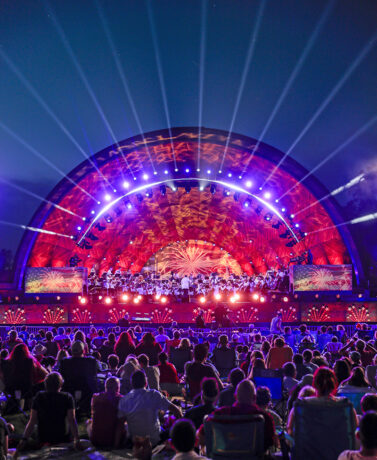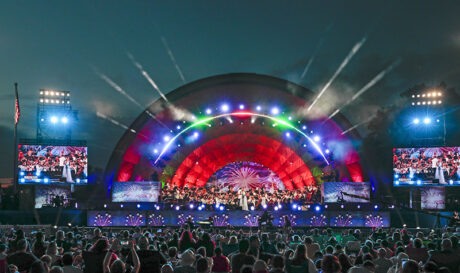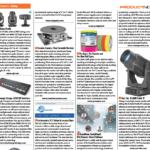
The 2022 Boston Pops Fireworks Spectacular concert was back on the Charles River in downtown Boston for the first time since 2019, after being cancelled due to Covid in 2020 and performing at Tanglewood in 2021. The event is one of the most recognized Independence Day celebrations in the country, including its presentation of Tchaikovsky’s “1812 Overture”—with real cannons—and spectacular fireworks display over the river.
Just like the Beantown audience, the production team was happy to be back at the Hatch Memorial Shell at the Charles River Esplanade. Among them Lighting Designer, Michael Berger of Full Flood, Inc. back for the sixth year lighting the iconic show. Berger notes, “Tanglewood last year was a different kind of special. It’s an environment that we don’t usually get a chance to go to and be in; while we were thrilled with the outcome of 2021, it didn’t have the feel of this one. This was the real return.”
The Full Flood team welcomed a new production partner supplying the lighting this year, the Seabrook, NH-based Port Lighting Systems. “In talking with the producers, our desire was to find a vendor that would truly be a partner on the show,” explains Berger. Working closely with Berger and his team, Port Lighting not only provided equipment but handled crewing as well. Port Lighting’s Senior Lighting Designer and Project Manager Graham Edmondson also served as gaffer for the production. “We were excited to be part of this event and pleased to provide all of the production lighting equipment, as well as labor,” says Edmondson. “We had some IATSE Local 11 stagehands, but primarily they were all freelancers who work with us.”

A Pop of Lighting
“We made some big changes in how the lighting of the show was structured, and basically let Port Lighting handle the entirety of the infrastructure. The team from Port did a fantastic job stepping into this role,” states Berger. “Graham, who gaffed the show for us, was also our Port account rep. We were able to combine both aesthetic needs of the show while balancing available equipment and labor requirements. There was a constant back and forth of design ideas and shop inventory. That’s the kind of experience that you can only get with a company that is providing turnkey production services, being a real partner on the show. If it was just a rental house, they wouldn’t necessarily care what we were trying to accomplish—only what gear they could provide. That’s really where Port Lighting stood out, they were a group of people that were interested in helping to create the show in the best way possible.”
The concert started during the day and moved into the evening. Due to scheduling, there was no camera rehearsal on July 3, so the lighting team was seeing the full show the same time as the audience. Berger went to some of the solutions he used on a previous show. “We had a similar situation on this year’s ACMs at Allegiant Stadium with daylight and the diffused white roof,” explains Berger. “Taking what we learned from that, we knew that intensity would be our biggest challenge in the first hour of the broadcast. Since our followspots provided much of the keylight, we decided to double hang the Robe RoboSpots. In the first hour of the show, we had them in multi-device mode where we had two lights following one person. As it got darker, we were pulling back the second light until we reached our normal broadcast level of one unit. Then on top of that, in a very beneficial way, our video controllers for the show were experienced sports TV engineers. They’re very used to sitting there, controlling the iris all the time. Usually on entertainment shows, we ask them to balance the iris and leave it in place. In this case, having their eyes and their hands as additional tools to balance really helped us get through that first hour of the concert.”

Quirks of the Hatch Shell
Lighting the orchestra inside the Hatch Memorial Shell can be a bit tricky since there is only one set of rigging points, so the lighting positions are very limited. “With the limited rigging points inside the shell, for the big arch truss becomes basically the only angle to light the orchestra; almost exclusively front light. We try to get around that with a great quantity of sources cross focusing to wrap light around the orchestra as much as possible. In addition to the front light angle there’s a small pipe in the back of the shell with some Robe LEDBeam 150s to act as back/sidelight. This year we were able to add some wireless Astera AX5s tucked into the side of the shell for practical backlight and happened to add nice eye candy which we’ve never had before.”
“It’s an older venue and there’s not a lot of infrastructure there,” comments Edmondson. “The Park Services recently put in a lot of power, which was very nice. This was the first year that lighting was able to all run off local power rather than generators, which helped a lot. The only infrastructure that we used from the Hatch Shell were rigging points for the big main truss arch downstage. Everything else was brought in. The scaffolding towers were built, and the stage was extended out.”
Key Equipment Choices
This year there was a desire to add more IP65 rated gear to deal with any potential weather issues. “We sought to specify a lot of IP rated gear this year and then of course got very little rain,” laughs Berger. “However, it poured the first day of load-in, so the effort wasn’t wasted. Normally, we’ve had to bag and un-bag all of the gear every night. Having so much IP65 rated gear this year saved time and money in avoiding that process.” Edmondson agrees, “Because we had so few lights that were not IP65 rated we only had six lights front of house that had to get bagged.”
Berger worked with Port Lighting Systems to fill out the gear list, “We landed on [Martin MAC] Auras, [Ayrton] Perseus-S, [Elation] Proteus Maximus, and [Chauvet] COLORado Solos as the IP65 rated workhorses,” says Berger. “With the limited positions and very oblique angles, shutters become necessary in our key/backlight fixtures. We’re throwing from so far and trying to cut into the drummer from 60˚ off his right, and not hit the person at the microphone. It’s a very tight shutter cut. With this venue for this show, it is just a situation where we really need that specificity of light.”
With 47 in the rig, making up the majority of Berger’s IP65 rated profiles, were the Ayrton Perseus-S luminaires. He explains that its IP65 nature drew him to it initially. “We knew that the Ayrton brand would be reliable and would perform well in the requirements of the show. It proved to fill its slot as both a key light and scenic treatment fixture for us this year. The fact that we didn’t have to worry about rain forcing them off was of great comfort. I was impressed by its brightness; even after balancing down to our color temp of 5,000K we were still brighter than any other arc source profile we’ve used in the past.”
Edmondson comments, “It came together very well in that Mike and his team have done this so many times that they’re pretty familiar with it. And we were pleased to be able to provide some new lighting options to them. There are always challenges along the way, especially in a venue like the Hatch Shell, but by and large it went pretty smoothly.” The Full Flood lighting team included Lighting Director, Will Gossett; Assistant Lighting Director, Hannah Kerman; and Programmers, Erin Anderson and Patrick Brazil.
As this was the first year that Port Lighting Systems supported the Boston Pops’ Fourth of July Concert, when asked why he felt they were the right company for the project Edmondson states, “There are two reasons. First, is that because we’d never done it before, we were really excited about it. I’ve worked in Boston for 12, 13 years and it’s a project that I’ve always been aware of, but never been involved in, so I was really pleased to work with Mike and his team on it. More importantly, everybody was just happy to be back there, which really helped with overall morale and mentality going in. It was great that Port could be part of that with everyone. The second thing is that Port had the ability to source and supply newer and more appropriate gear to the project. Being able to bring in all of the IP65 rated moving lights; being able to use the right gear for the application meant that everything went a whole lot better. The show looked great.” Edmondson adds, “We get to do a lot of cool and exciting events, but this being such a prominent event made it different. This is a quintessential Boston event, and it was really cool to be able to be a part of it.”
Being back on the Charles River for this beloved event was “fantastic,” Berger says. “A special thing for me on this show is the place it holds with people, the tradition of it in their lives, in the city. It’s when we leave to go to the venue on the morning of the third at four a.m. and just every street is completely shut down and you’re walking across Storrow Drive and there’s not a car to be seen. It’s where the weight of the event itself comes into play and you realize the importance of the event for the city. That’s such an exciting moment. Growing up in Boston and to now be a part of creating this event, that gets me every year.”



